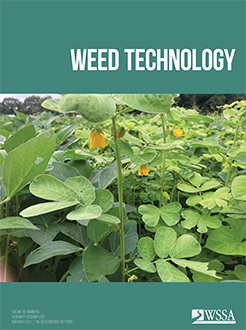Glyphosate is the most widely used herbicide in the United States; however, concern is escalating about increasing residues of glyphosate and its metabolite aminomethylphosphonic acid (AMPA) in soil. There is a lack of scientific literature examining the response of cover crops to soil residues of glyphosate or AMPA. The objectives of this study were to evaluate the impact of glyphosate or AMPA residues in silty clay loam soil on emergence, growth, and biomass of cover crops, including cereal rye, crimson clover, field pea, hairy vetch, and winter wheat, as well as their germination in a 0.07% (0.7 g L-1) solution of AMPA or glyphosate. Greenhouse studies were conducted at the University of Nebraska–Lincoln to determine the dose response of broadleaf and grass cover crops to soil-applied glyphosate or AMPA. The results indicated that soil treated with glyphosate or AMPA up to 105 mg ae kg–1 of soil had no effect on the emergence, growth, above-ground biomass, and root biomass of any of the cover crop species tested. To evaluate the impact of AMPA or glyphosate on the seed germination of cover crop species, seeds were soaked in Petri plates filled with a 0.7 g L-1 solution of AMPA or glyphosate. There was no effect of AMPA on seed germination of any of the cover crop species tested. Seed germination of crimson clover and field pea in a 0.7 g L-1 solution of glyphosate was comparable to the nontreated control; however, the germination of cereal rye, hairy vetch, and winter wheat was reduced by 48%, 75%, and 66%, respectively, compared to the nontreated control. The results suggested that glyphosate or AMPA up to 105 mg ae kg–1 in silt clay loam soil is unlikely to cause any negative effect on the evaluated cover crop species.
Nomenclature: Aminomethylphosphonic acid (AMPA); glyphosate; cereal rye; Secale cereale L.; crimson clover; Trifolium incarnatum L.; field pea or Austrian winter pea; Pisum sativum L.; hairy vetch; Vicia villosa Roth; winter wheat; Triticum aestivum L.






